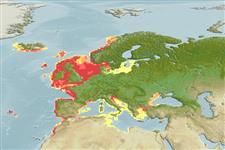Common names from other countries
Environment: milieu / climate zone / depth range / distribution range
Écologie
; profondeur 0 - 150 m (Ref. 4), usually ? - 50 m (Ref. 4). Subtropical, preferred 12°C (Ref. 107945); 69°N - 29°N, 28°W - 32°E (Ref. 4)
Distribution
Pays | Zones FAO | Écosystèmes | Occurrences | Introductions
Eastern Atlantic, Mediterranean and Black Sea. Not in east of Crete and in the Baltic Sea.
Length at first maturity / Taille / Poids / Âge
Maturity: Lm 8.9, range 8 - 8.3 cm Max length : 65.0 cm TL mâle / non sexé; (Ref. 441); common length : 40.0 cm TL mâle / non sexé; (Ref. 441); poids max. publié: 6.0 kg (Ref. 4); âge max. reporté: 72 années (Ref. 81081)
Common total length: 23 to 50 cm. Occurs on the continental shelf at depths of 0 to 150 m, usually not deeper than 50 m. Found on hard substrates such as rock or hard mud. Nocturnal and territorial living in holes or crevices. Females with eggs are usually found throughout the year. The eggs are laid around July and carried for 10 to 11 months (Ref. 4). Indiscriminate scavengers, omnivorous or carnivorous. Feeds primarily on malacostracan crustaceans, gastropod mollusks, and polychaete annelids; but diet known to include carrion, echinoderms, lamellibranchs and plant matter (Ref. 96319).
Females with eggs are usually found throughout the year. The eggs are laid around July and carried for 10 to 11 months (Ref. 4). Coupling occurs a few days after the female molts (Ref. 80921).
Holthuis, L.B. 1991. (Ref. 4)
Statut dans la liste rouge de l'IUCN (Ref. 130435)
statut CITES (Ref. 108899)
Not Evaluated
Not Evaluated
Utilisations par l'homme
Pêcheries: hautement commercial; Aquaculture: expérimental
FAO - pêcheries: landings, species profile | FishSource | Sea Around Us
Outils
Sources Internet
Estimates based on models
Preferred temperature
(Ref.
115969): 7.7 - 13.3, mean 10.4 (based on 494 cells).
Résilience
Haut, temps minimum de doublement de population inférieur à 15 mois (K=0.79-1.0; Fec=13,000).
Prior r = 0.37, 95% CL = 0.25 - 0.56, Based on 1 data-limited stock assessment.
Vulnérabilité
Moderate to high vulnerability (46 of 100).
